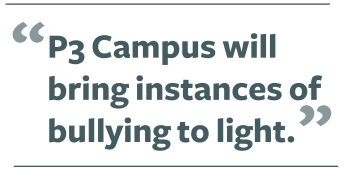Addressing Bullying- P3
Learn what P3 is and how it can help address bullying, as well as ways to respond effectively to bullying situations.
- Emergency Management
- Connect360
- PBIS Rewards
- Hall Pass
- Preparation & Response Training
- Behavioral Case Manager
- Visitor Management
-
Compass
Getting Started Webinar Links Data & User Management Compass Curriculum for Students, Staff, & Families Compass Behavior Intervention Compass Mental Health + Prevention Compass for Florida - Character Ed, Resiliency, & Prevention Compass for Texas - Character Ed Analytics & Reporting Release Notes & Updates Additional Resources
- School Check In
- ALICE Training Institute
- Detect
- Anonymous Tip Reporting
- Resources
- Back-to-School

We all recognize that bullying is a serious problem. From the headlines to the classrooms to the kitchen tables, we see it, but we can’t seem to stop it. Worse yet, often adults can’t readily identify it. P3 Campus will bring a lot of instances of bullying to light. The role of schools then is to handle these cases carefully and properly. Improperly adressing these cases can, at best, have no effect or, at worst, exacerbate the situation and mask social and emotional needs of the perpetrator.

Despite our best efforts and intentions, combatting bullying has proven non-intuitive. However, developments in research have yielded some valuable findings. Effective solutions must build on evidence-based recommendations and strive for new ways to understand complex problems. Below details some of the ways intuitive responses to bullying situations have been counterproductive.
From “Misdirections in Bullying Prevention and Intervention” by StopBullying.gov:
|
Zero Tolerance Policies Many schools and school districts have “zero tolerance” or “three strikes and you’re out” bullying policies. These policies suspend or expel children who bully others. However:
Although suspension and expulsion may be necessary in a small number of cases, they should not be the standard bullying prevention or intervention policy. Conflict Resolution and Peer Mediation Conflict resolution and peer mediation are common strategies for dealing with issues between students. Because of this, schools may use these methods to address bullying problems. However:
Group Treatment for Children Who Bully Some schools use group therapy to address bullying behavior. This therapy teaches children who bully how to manage anger while building skills, empathy, and self-esteem. Although these programs have the best intentions, students’ behavior may get even worse. Group members tend to serve as role models for each other, which typically reinforces antisocial or bullying behavior. Simple, Short-Term Solutions Schools often adopt short-term bullying prevention and intervention approaches that don’t address the entire issue. For example, bullying may be the topic of staff in-service training, a PTA meeting, a school-wide assembly, or lessons taught by individual teachers. Although each of these efforts is an important piece of a bullying prevention and intervention strategy, none of these alone is sufficient. Because of that, they are not likely to significantly reduce bullying problems. To reduce the prevalence of bullying, the school’s climate and its exceptions for student behavior must change. |